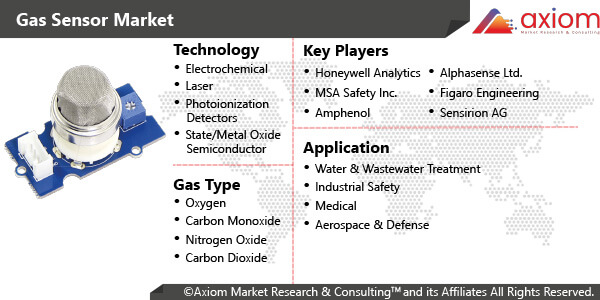A gas sensor is an instrument which detects the concentration or presence of gases in the environment. Depending on the concentration of gas the sensor releases a corresponding difference by changing the resistance of the material which is present inside the sensor and it can be measured as output voltage. Working of gas sensor depends on the concentration of particular gases present in the atmosphere. The sensor provides a reference point and scale, which produces a measurable electric current when a chemical reaction occurs caused by a specific gas. These sensors are commonly used to detect explosive gases or toxic gases and also measure gas concentration. There are four types of gas sensors: electrochemical (echem), catalytic combustion, infrared (IR), photoionization detectors (PID). When these sensors sense gas, they convert input into a reading on the display displaying the level of gas exposure.
Gas Sensor Market Dynamics
Increase in demand for gas sensors in critical industries is uplifting the market growth of gas sensors. Various industries such as mining, oil & gas, chemical and power make use of gas sensors to monitor and detect the presence of various toxic and combustible gases. Huge number of gases such as carbon dioxide, carbon monoxide, ammonia and hydrocarbons are released into the air by these industries. Excess amount of emission of these gases can affect human health adversely. Moreover, there are some other explosive gases such as propane, butane, methane that might be released by different critical industries, which further may lead to chances of fire accidents. Government is investing huge amounts to secure ecosystem from various harmful gases. Intense pricing pressure is one of the major restraining factor of gas sensor market. While the huge spread application of gas sensors in HVAC systems, automobiles and consumer devices leads to growing shipments of these sensors, the sales growth is restrained by pricing pressure. Furthermore, rising price pressure results in a fall in average selling price (ASP) which Detroit revenue growth in the highly competitive gas market.
COVID 19 Impact on Magnetic Sensor Market
COVID-19 pandemic has spread across 215 countries worldwide affecting various industries worldwide. As the world is continuously fighting these crisis, various industries are experiencing the constant decline. Due to temporary lockdowns across various countries companies are facing acute cash flow issues. Slowing down and halting of manufacturing processes along with disruption in supply chain logistics worldwide owing to the outbreak of coronavirus pandemic, have impacted the gas sensors market as well.
Gas Sensor Market segmental overview
The report analyses of the Gas Sensor Market based on technology, gas type, application and by geography.
Gas Sensor Market by Technology
By technology, the global gas sensor market is segmented into electrochemical, laser, photoionization detectors, solid state/metal oxide semiconductor, catalytic, infrared, others.
Gas Sensor Market by Gas Type
The gas sensor market by gas type is classified into oxygen, carbon monoxide, nitrogen oxide, carbon dioxide, hydrogen sulfide, methane, hydrogen, others. Oxygen gas sensor holds the largest market share. Oxygen analyzers, detectors and monitors are highly used in smart cities, automotive industry, food and beverages industry and other applications. Medical equipment is also one of the major sectors which makes use of oxygen sensors as they are used in hypoxic life science products, respirators and oxygen concentrators and also in incubators.
Gas Sensor Market by Application
The gas sensor market by application is classified into water & wastewater treatment, industrial safety, medical, aerospace & defense, automotive & transportation, oil & gas, consumer electronics, environmental monitoring, others. Automotive & transportation holds the largest market share. The air quality in the vehicle cabin is highly affected due to the entry of toxic gases through the ventilation systems, pollutants entering through window opening, lack of fresh air and low concentration of oxygen. Strict environmental and safety regulations force all automotive and transportation OEMs (original equipment manufacturer) to inherit gas sensors in their offerings.
Gas Sensor Market by Geography
Geographically, the gas sensor market is studied across the countries of key regions such as, North America, Europe, Asia Pacific and the rest of the world regions which includes Latin America, and Middle East & Africa. Asia pacific holds the largest market share. Asia pacific is considered to be the region of emerging markets. China and India are the fastest emerging countries. China acquires first position in automotive production which furthers adds to one of the significant advantages for gas sensors market in this region. India is the largest producer of the genetical drugs. Furthermore, Indian pharmaceutical sector fulfils 50% of the global demand. Pharmaceutical sectors make use of solvents and gases in the process of manufacturing and the monitoring is continuous, which further raises the demand for gas sensors, which further uplifts the market in this region.
Gas Sensor Market Key Players
Some of the major players operating in this market include Honeywell Analytics (UK), MSA Safety Inc. (US), Amphenol (US), Alphasense Ltd. (UK), Figaro Engineering (Japan), Sensirion AG (Switzerland), Dynament Ltd. (UK), Sensirion AG (Switzerland), MEMBRAPOR AG (Switzerland), ams AG (Austria) and Senseair AB (Sweden).











